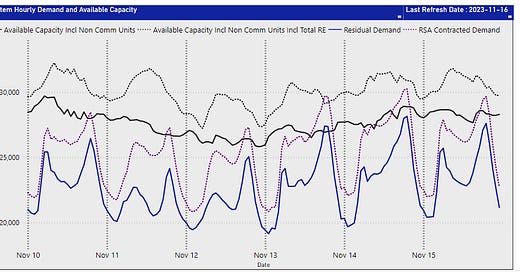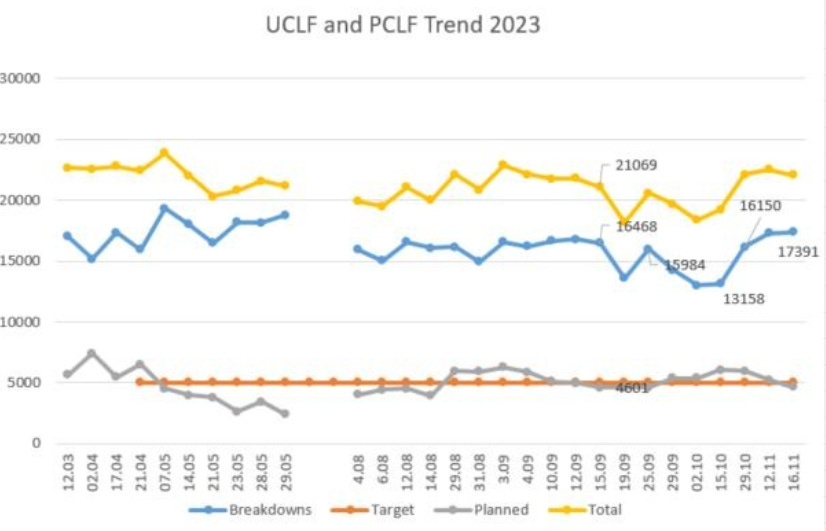I have been like a broken racket on the issue of maintenance, but I will say it again. Ending loadshedding only requires 1-3GW of additional capacity, it comes down to fixing a few plants so that the evening peak can be met.
Eskom almost achieved it by targeting the Unplanned Capacity Loss Factor (UCLF), by keeping it below 13GW, during the period of the Rugby World Cup.
There has been many plans on the table to “fix Eskom” and they all coalesce on the same story. Below is one of the many that was given to me by a few former Eskom employees, investors in the energy sector, and other relevant stakeholders.
Eskom has roughly 50GW of installed generation capacity. Almost half are out of action, with on average 5GW in planned maintenance and 16GW in breakdown. Under the status quo, Eskom will impose rolling blackouts for 5-7 years and will eventually implode.
The focus should be to fix Eskom plants. It takes less time to fix existing plants than to permit and construct new plants. South Africa has the skills to fix Eskom and operate its stations efficiently, as is done world-wide. The power sector can simultaneously be restructured, for example with IPPs and privatisation.
Eskom should, and its shareholder should commit publicly and in law:
Fix 40 GW of the fleet of coal-fired power plants, not apologise for it being a coal fleet. Coal is supplied domestically, must be transported by railway rather than trucks, no foreign currency implication and accretive to employment. Overhauling a new plant should ideally take 8 months, but with lack of routine experience it can take up more than 1 year (as was the case with Koeberg’s Life Extension).
The Government would bolster Eskom’s balance sheet, assume part of the debt and invoices overdue by municipalities to Eskom, which Eskom could in turn use to repay debt.
Establish a 20 GW renewable program with 4 GW wind and solar awarded annually for 5 years (established in law). Competitive bidding with complete certainty, provided by the private sector.
Establish a 5 GW rooftop solar program with a R1.75/kWh feed-in-tariff without escalation valid for 5 years with a construction window of 24 months. Net metering for own use and export to municipal grid.
Small businesses can be assisted to become “micro power plant operators” with micro lending schemes. The scheme requires no grid connection or security, can be distributed throughout the country and operated by an App.
Select and advance pumped storage schemes to counteract the intermittency of the above. Pumped storage has 20% of the LCOE as batteries, with a 10 year lead-time and a 40 year design life.
Select and advance an LNG Import facility at Richardsbay. LNG worldwide is a buyers market, with low prices it makes more sense currently to import than to exploit domestically.
IPO the transmission grid to raise $20 billion. Apply $10 billion to substantially improve the grid and $10 billion to repay Eskom debt.
IPP program to exploit domestic gas and balance renewables, with sensitivity to currency impact of imported gas.
IPP program to exploit the latest clean coal technologies.
Select and advance a new NPP nuclear projects, including SMRs. The lead-time is around 10 years.
Nersa should explore selling electricity as a service, to incentivise demand side management and to prevent Eskom’s death spiral through cost reflective tarrifs.
Allow Eskom to sell direct to its customers, to bypass the municipal middlemen.
Set aside all ideological environmental ideas and prioritise energy in the following order, energy security, energy equity and environmental conditions.
Remove NERSA’s licencing laws and ability to fix tariffs (the root cause of load shedding in my view).
South Africa should have an open debate about racial classification and ask deeper questions as to why our skilled workforce would rather go to Australia, the USA, UK, France and elsewhere. The majority of those who helped me with understanding Eskom’s issues no longer stay in the country, but they are still loyal citizens.
Estimates to “fix” load shedding is 18 months to 3 years, others reckon that it will take up to a decade. Some of the above has already been done by government so I do give them credit for listening.





Excellent analysis. It really should not be a difficult problem to solve following a logical process. The problem is lack of clear analysis combined with a bias against reliable generation like coal, gas and nuclear and poor understanding of the challenge of internittancy. Solar and wind can help but it cannot replace reliable generation until we have built storage.
We don't have a technical problem, we have a political problem. You cannot make the right mega infrastructure decisions while the ruling party is split. This is not an ANC thing this is how politics works globally. If you are fighting internally for survival you can just not make the tough decisions.